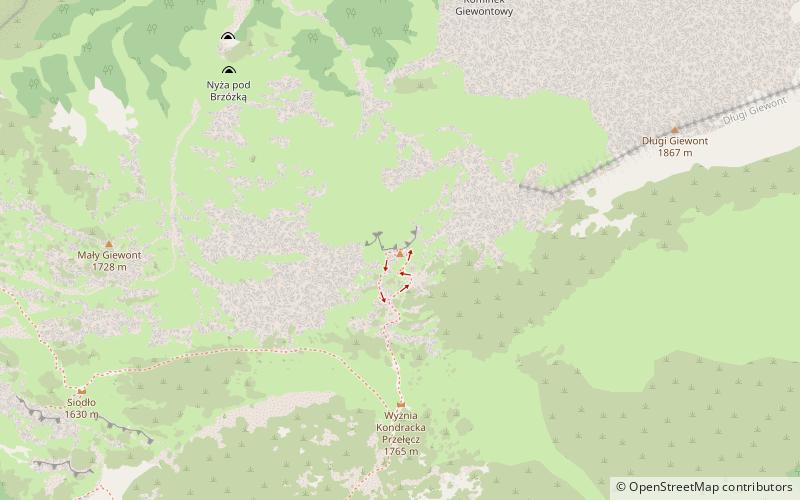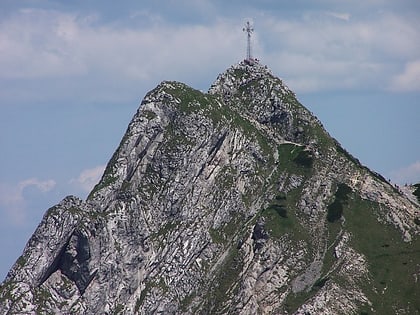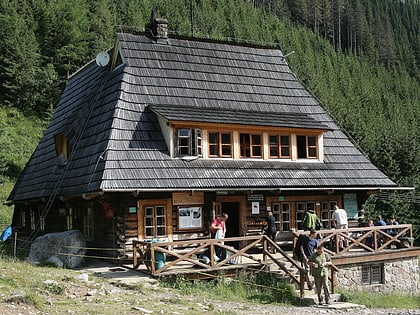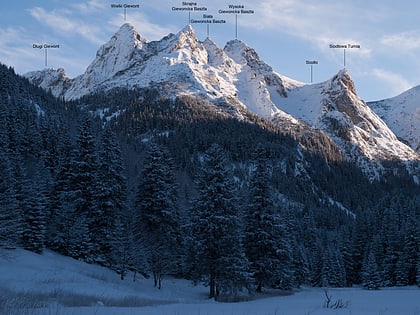Krzyż na Giewoncie, Tatra National Park


Facts and practical information
Cross on Giewont - a metal cross on top of the Great Giewont in the Giewont massif. It was installed there by parishioners from Zakopane on 19 August 1901 to commemorate the 1900th anniversary of the birth of Jesus Christ. The initiative came from the then parish priest of Zakopane, Kazimierz Kaszelewski. In order to find out how high the cross would be needed to be visible from Zakopane, a test was made: a 10.5 m high cross was made of two long poles taken from a hut - it was visible. The metal cross was made in elements by Górecki's factory in Krakow and transported by train.
The cross is 17.5 m high, of which 2.5 m is buried in the rocks, the cross arm is 5.5 m long. It consists of 400 iron elements with a total weight of 1819 kg, which were transported by horse-drawn carts to Hala Kondratowa, and then carried to the top on the back. Half a thousand people worked on this, eighteen carts were used. In addition to the metal elements 400 kg of cement and 200 canvas water containers were carried. The assembly took 6 days. It was done by six highlanders and Górecki's workers under his personal supervision. At the crossing of the cross arms there is an inscription: Jesu Christo Deo, restitutæ per ipsum salutis MCM. The cross was consecrated on 19 August 1901 by the Rev. Canon Chancellor Bandurski of Cracow during a mass on Giewont, attended by about 300 people.
In 1975 the cross was renovated. Young people under the supervision of parish priest Wladyslaw Curzydla brought 1200 kg of sand, 200 kg of cement and water for concrete from Hala Kondratowa to the top of Wielki Giewont. The concrete filled the breach under the cross and strengthened the rocks of the peak by gluing them together. The mountaineer Krzysztof Szafrański painted the cross construction in celadon colour, protecting it against corrosion. In 1994 a Cracovian company repairing the tourist route repainted the cross. In order to stabilize the summit dome, 14 steel anchors were mounted, sunk 1 m deep into the rock, and the loose rock fragments were glued with a special mineral glue. In 2000 a stained glass window with the Merciful Christ and the inscription "Jesus I trust in you" was installed on the cross. In June and July 2009 another renovation of the cross was carried out.
Giewont is one of the most popular Polish mountains among tourists. The cross itself on Giewont is also the object of religious pilgrimages. August 19 and 14 September is from the Holy Cross Church in Zakopane pilgrimage to the cross on Giewont.
Cross standing on Giewont towering over Zakopane is a characteristic and well recognizable element. You can observe it through a telescope from the top of Gubałówka.
It is very dangerous during thunderstorms. On August 19, 1937, 4 people were killed and 13 were stricken by lightning during a pilgrimage. The biggest accident occurred on August 22, 2019. - as a result of lightning strikes, 4 people died and nearly 100 were stricken. It is imperative to get off the summit during an approaching storm.
On September 6, 2007 the cross was entered into the register of monuments of the Malopolska province. Since 2007 a replica of the cross, the Baltic Cross of Hope, has been standing in Pustkow on the Baltic Sea. Another copy stands on the fields of Lednica. As part of the celebrations of the Great Jubilee of the Year 2000, a replica of the cross on Giewont was placed in Wojcieszow in Lower Silesia.
Tatra National Park
Krzyż na Giewoncie – popular in the area (distance from the attraction)
Nearby attractions include: Giewont, Jaskinia Wielka Śnieżna, Shelter Hala Kondratowa, Siodłowa Turnia.











